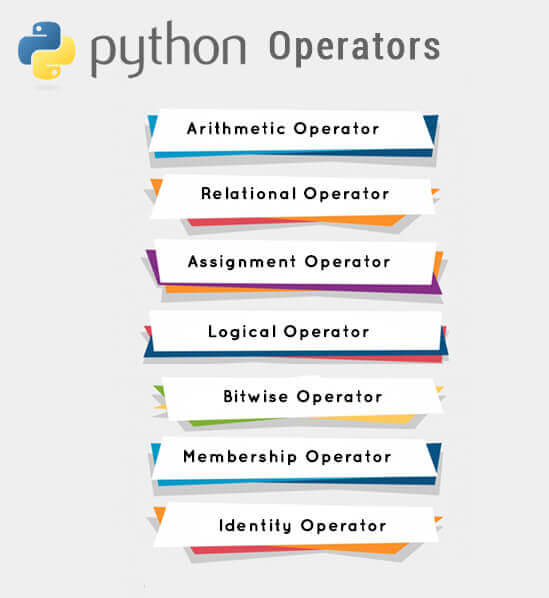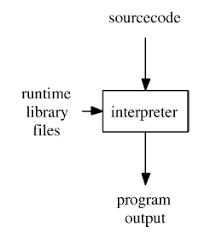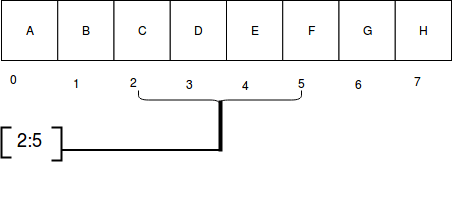Interview :: python
Python uses a rich set of operators to perform a variety of operations. Some individual operators like membership and identity operators are not so familiar but allow to perform operations.
- Arithmetic OperatorsRelational Operators
- Assignment Operators
- Logical Operators
- Membership Operators
- Identity Operators
- Bitwise Operators

Arithmetic operators perform basic arithmetic operations. For example "+" is used to add and "?" is used for subtraction.
Relational Operators are used to comparing the values. These operators test the conditions and then returns a boolean value either True or False.
# Examples of Relational Operators
Assignment operators are used to assigning values to the variables. See the examples below.
Logical operators are used to performing logical operations like And, Or, and Not. See the example below.
Membership operators are used to checking whether an element is a member of the sequence (list, dictionary, tuples) or not. Python uses two membership operators in and not in operators to check element presence. See an example.
Identity Operators (is and is not) both are used to check two values or variable which are located on the same part of the memory. Two variables that are equal does not imply that they are identical. See the following examples.
Bitwise Operators are used to performing operations over the bits. The binary operators (&, |, OR) work on bits. See the example below.
In Python 3, the old Unicode type has replaced by "str" type, and the string is treated as Unicode by default. We can make a string in Unicode by using art.title.encode("utf-8") function.
Python is an interpreted language. The Python language program runs directly from the source code. It converts the source code into an intermediate language code, which is again translated into machine language that has to be executed.
Unlike Java or C, Python does not require compilation before execution.

Memory is managed in Python by the following way:
- The Python memory is managed by a Python private heap space. All the objects and data structures are located in a private heap. The programmer does not have permission to access this private heap.
- We can easily allocate heap space for Python objects by the Python memory manager. The core API gives access of some tools to the programmer for coding purpose.
- Python also has an inbuilt garbage collector, which recycle all the unused memory and frees the memory for the heap space.
Decorators are very powerful and a useful tool in Python that allows the programmers to modify the behaviour of any class or function. It allows us to wrap another function to extend the behaviour of the wrapped function, without permanently modifying it.
Functions vs. Decorators
A function is a block of code that performs a specific task whereas a decorator is a function that modifies other functions.
In Python, variables that are only referenced inside a function are called implicitly global. If a variable is assigned a new value anywhere within the function's body, it's assumed to be a local. If a variable is ever assigned a new value inside the function, the variable is implicitly local, and we need to declare it as 'global' explicitly. To make a variable globally, we need to declare it by using global keyword. Local variables are accessible within local body only. Global variables are accessible anywhere in the program, and any function can access and modify its value.
The namespace is a fundamental idea to structure and organize the code that is more useful in large projects. However, it could be a bit difficult concept to grasp if you're new to programming. Hence, we tried to make namespaces just a little easier to understand.
A namespace is defined as a simple system to control the names in a program. It ensures that names are unique and won't lead to any conflict.
Also, Python implements namespaces in the form of dictionaries and maintains name-to-object mapping where names act as keys and the objects as values.
In Python, iterators are used to iterate a group of elements, containers like a list. Iterators are the collection of items, and it can be a list, tuple, or a dictionary. Python iterator implements __itr__ and next() method to iterate the stored elements. In Python, we generally use loops to iterate over the collections (list, tuple).
In Python, the generator is a way that specifies how to implement iterators. It is a normal function except that it yields expression in the function. It does not implements __itr__ and next() method and reduce other overheads as well.
If a function contains at least a yield statement, it becomes a generator. The yield keyword pauses the current execution by saving its states and then resume from the same when required.
Slicing is a mechanism used to select a range of items from sequence type like list, tuple, and string. It is beneficial and easy to get elements from a range by using slice way. It requires a : (colon) which separates the start and end index of the field. All the data collection types List or tuple allows us to use slicing to fetch elements. Although we can get elements by specifying an index, we get only single element whereas using slicing we can get a group of elements.

